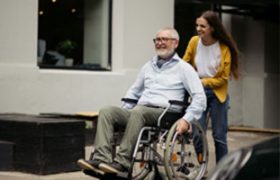ASSISTIVE TECHNOLOGY
The primary goal of assistive products is to retain or improve a person’s functioning and independence, thereby promoting their well-being. They make it possible for people to live healthy, productive, independent, and dignified lives, as well as to participate in education, the labour market, and civic life.
Providing support and assistance to individuals with disabilities, limited mobility, or other impairments to perform functions that would otherwise be difficult or impossible. Individuals can use these devices to assist them in improving or maintaining their daily quality of life by easing or compensating for their injuries or disabilities.
What is Assistive Technology (AT) in the NDIS?
The NDIS uses the definition of Assistive Technology (AT), as defined by the World Health Organisation: ‘any device or system that allows individuals to perform tasks they would otherwise be unable to do or increases the ease and safety with which tasks can be performed’.
The NDIS funds Assistive Technology that provides the support a person with a disability might use to reach their potential at home, in the community and the workplace and in so doing work towards reaching the goals in their NDIS plan.
AT under the NDIS does not include:
- Items for treatment or rehabilitation
- Built environment that is used by all – for example, ramps, pathways, and lifts
- Mainstream technology that does not overcome a functional limitation but modifications to this technology could be AT – for example, a car would not be AT but modifications to the car could be AT
- Something that does not include a device – for example, medicine or training
Who can benefit from assistive technology?
As life is very uncertain, one might need an assistive technology at some time in their life.
According to the WHO one billion people need assistive products today and more than two billion people around the world are expected to need at least one assistive product by 2030.
While one might need at some point in their life, Assistive technology is most needed by the following people:
- people with disabilities
- elderly people
- people with noncommunicable diseases such as diabetes and stroke
- people with mental health conditions including dementia and autism
- people with gradual functional decline.
How to Choose the right assistive technology:
The decision you make is often based on the advice of a team of professionals and consultants trained in matching assistive technologies with your exact needs. Generally, an assistive technology team may include family doctors, regular and special education teachers, speech-language pathologists, rehabilitation engineers, occupational therapists, and other specialists including consulting representatives from companies that manufacture assistive technology.
Use and importance of assistive technology can allow individuals to:
It is important to recognize that without assistive technology, people are excluded, isolated, and locked into poverty, increasing the impact of disease and disability on a person, their family, and society at large.
AT helps people with disability to take care for themselves and their families, work to support their family, access information through computers, enjoy recreational activities, participate with others in social activities, learn with others in an authentic school environment and in educational institutions.
Assistive technology also proves to be a boon for the people who interact with people using such technology.
Types
Assistive technology solutions can range from no and low tech to high tech. In many cases, AT may fit into more than one category, depending on the person’s needs, their location, and how they use it.
ASSISTIVE TECHNOLOGY FOR VARIOUS DISABILITY
MOBILITY, SEATING, AND POSITIONING
- canes,
- crutches,
- wheelchairs,
- walkers,
- scooters, and
- power chairs
- prosthetics
These all are examples of mobility aid.
The purpose of some mobility aids is to perform specific tasks, such as canes are used for walking or using wheelchairs to do tasks such as getting up or down. Others, like scooters and prosthetics, can be used for many other activities.
Mobility varies from person to person. For some people use of crane, walkers are enough for their mobility, but some might need to use their mouth or head for movement.
DRIVING AIDS
In some cases, driving with a disability requires relearning the basics. Although the rules of the road remain the same, the controls have changed. There are several types of adapted vehicles, depending on the individual’s needs. Such vehicles include several devices that help them while driving, they are:
- Hand Controls
Braking and accelerating can be made easier with hand controls. Those who cannot otherwise reach the pedals or who have limited foot mobility can use this. - Power Assist Devices
The use of power assist devices makes steering easier. It is especially beneficial for people who have weak muscles or arthritis.
- A wheelchair lift
To make getting into and out of a car easier, a wheelchair lift can be installed. A wheelchair-accessible van is also available.
- Joysticks
People with limited hand functions can also use joysticks. These are just a few examples of how mobility aids can help people with disabilities.
PHYSICAL MODIFICATIONS
These modifications can be made to a home, office, or any other building.
- Ramps
Ramps help those who use wheelchairs or scooters get in and out of buildings. They can also be used to get into vehicles. The ramps are lightweight and easy to move around from building to building. - Handles
Handles can be added or modified to make them easier for those with arthritis or limited hand function. With ergonomic grip and basic customization, handles will provide a better experience people with disability.
A fulfilled life requires good mental health. A healthy mind is as essential as a healthy body. Our mind encompasses.
Support Coordinators are an important resource for many NDIS participants. But what exactly is a support coordinator and how do you.
As of March, the NDIS Senator made an announcement stating that there is an increase in the limit for mid-cost.
It can be tricky to comprehend how funding for overnight care and support under the NDIS works. Let’s examine the.
For participants who are eligible, we highly recommend utilising NDIS plan management to assist in managing their NDIS plan funding..
What is a Regional Area Coordinator? At 9D Care, our biggest priority is ensuring that our participants are well taken.
Our team can come to you to discuss face to face your needs and discuss how we can best support you to achieve your goals. Contact us today to arrange an appointment.







